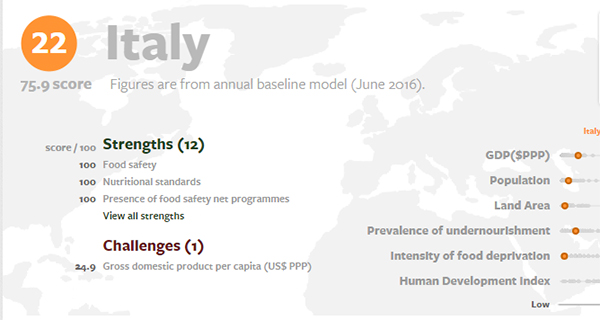
A GLOBAL INDEX PROVIDES A FRAMEWORK FOR ACTION AND DIALOGUE IN THE FOOD INDUSTRY- The Aspen Institute’s Food Security Strategy Group identified the Economist Intelligence Unit latest Global Food Security Index (GFSI) as a critical tool in prioritising target areas for action and leadership on global food security. In the light of current food security challenges in worldwide countries, the GFSI stresses that advancements in food safety has become a priority in the Italian Food and Beverage industry in home market and abroad, according to The Economist. Moreover, as EIU found, overall economic growth, for example Italy, drove food security gains by falling food prices and rising incomes, but a lack of basic infrastructure inhibited steps furthermore. Food security has improved in home market over the past five years, but healthy worries and food insecurity still persist. Governments, multilaterals and the private sector should remain proactive in addressing food-security challenges.
 WHY THIS IS IMPORTANT? – The GFSI, which is sponsored by DuPont, is an annual benchmarking index that provides a common framework for understanding the root causes of food quality by examining the dynamics of food&beverage industries around the world, through which the global index has created a unique country-level food safety measurement tool that addresses the issues of affordability, availability and utilisation in 113 countries worldwide.
WHY THIS IS IMPORTANT? – The GFSI, which is sponsored by DuPont, is an annual benchmarking index that provides a common framework for understanding the root causes of food quality by examining the dynamics of food&beverage industries around the world, through which the global index has created a unique country-level food safety measurement tool that addresses the issues of affordability, availability and utilisation in 113 countries worldwide.
MORE COUNTRIES TO EXPERIENCE DECLINES IN THEIR SCORES FOR NATIONAL NUTRITIONAL STANDARDS – Actually global food security around the world continues to progress but the bulk of growth is concentrated in middle-income economies. Low-income countries often lack basic infrastructure, and smaller incomes inhibit access to and affordability of nutritious food. Political risk and corruption frequently compound structural difficulties in these countries, exacerbated by the risk of future climate change. Changing weather patterns, drought, increased rainfall and flooding will have a significant impact in the long term, potentially pushing up food prices and increasing production volatility. The risk associated with climate change, population growth and potential spikes in food prices pose threats to the most food-insecure populations, as poor countries are the least able to deal with these factors, EIU added.
